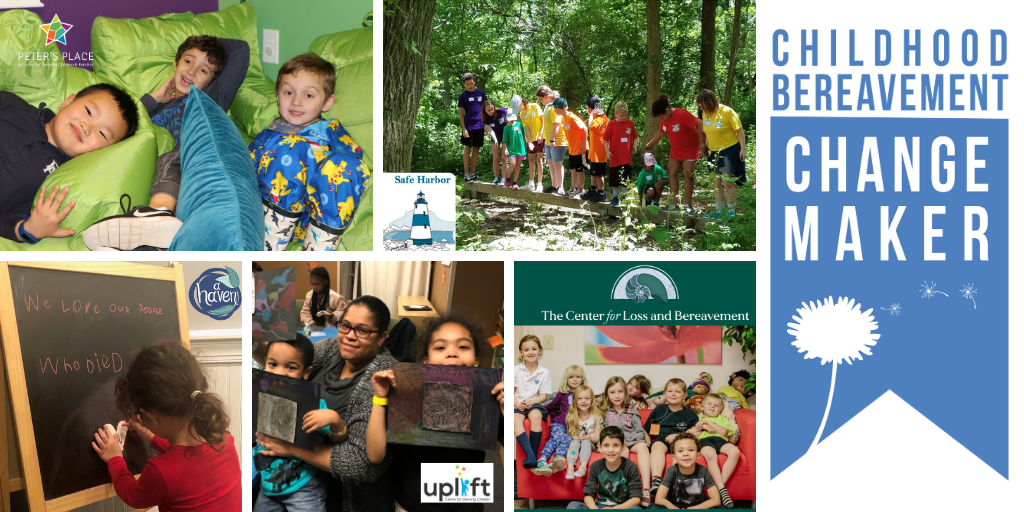Impact Stories
Philadelphia Area Changemakers Sharing the Love
febrero 24, 2021

It all started with a glance, as many great stories do.
Catsy Pemberton, Executive Director of Peter’s Place, a children’s bereavement center in the Western suburbs of Philadelphia, remembers exchanging glances with friend and fellow Executive Director, Darcy Walker Krause, J.D., LSW, C.T. of Uplift Center for Grieving Children in Philadelphia at the National Alliance for Grieving Children (NAGC) Symposium in June of 2019. Catsy and Darcy serendipitously sat next to each other at the Judi’s House/JAG Institute Childhood Bereavement Estimation Model (CBEM) breakout session where our team launched the Childhood Bereavement Changemaker (CBC) initiative, a national partnership to bring bereavement centers from across the nation together to better understand the full spectrum of childhood bereavement in the U.S. Philadelphia is the sixth-largest city in the country and as such, Catsy and Darcy both saw an opportunity to unite grief centers serving the city’s five-county area and apply as one – The Greater Philadelphia Grief Collaborative (GPGC).
Joined by A Haven, Safe Harbor of Abington Jefferson Health, and The Center for Loss and Bereavement, the collaborative was selected as a Changemaker later that year.
Catsy gave us an inside look into how this Changemaker partnership in and around the City of Brotherly Love has blossomed into a crucial support network for those grieving in Southeastern Pennsylvania.
Timing is everything
Fast forward to present. A global health crisis has disrupted routines, more than 500,000 Americans have died from COVID-19, our nation continues to be shaken by acts of racism and violence, and grief has taken center stage. Working together through the Changemaker process this past year, members of the GPGC have fortified their connections to each other and strengthened grief care in the unique communities they serve.
The Philadelphia five-county area, served by the Collaborative, has a population of more than 4 million people and each center is located in a different geographic hub. And although they share a similar mission, each center offers a variety of programs; therefore, providing them the opportunity to make referrals to each other to best match the needs of those interested and in need of services.
“It’s been wonderful that we know each other’s organizations more deeply. We can make referrals with a warm touch.”
Discovering possibilities
As a Changemaker, members of the GPGC will receive a custom report that details childhood bereavement prevalence in their specific service areas. The Collaborative represents diverse communities with equally diverse grief needs. By comparing current client data and community demographics specific to childhood bereavement, the report will demonstrate who is being served and uncover any service gaps. The centers will be armed with information that identifies community needs through an exploration of leading causes of death and socioeconomic indicators.
“We all had ideas of what grief looked like in the communities we serve, but we didn’t even scratch the surface…It’s great to see where we are all doing well, but there’s so much where we’re not making an impact. There’s just so much grief.”
There is growing excitement from Catsy’s collaborative counterparts to dive deeper into the CBC reports to make data-informed decisions to better address under-resourced communities moving forward.
Walking the journey differently
As national awareness of long-standing racial inequality increases, grief centers are preparing to support bereaved clients not only in managing their loss, but also in navigating the compounded grief brought on by more than 400 years of oppression and discrimination. Research shows COVID-19 has a disproportionate impact on communities of color.
Each GPGC organization is working individually on addressing racial inequalities in access to grief and mental health resources as well as delivery of services. They are eager to employ the CBEM information to utilize a data-informed approach to this process. Catsy and her fellow collaborators understand there is much work to be done in learning how to best support people of color who are grieving while appreciating and valuing that everyone grieves in their own way. This is especially important for children.
“Every child should be welcomed for their uniqueness. Everyone walks the journey differently.”
Using data from the CBC process, the GPGC can identify local youth-serving partners to help introduce their services and ensure accessible grief care.
Planning for the future
COVID-19 has forced each of us to reinvent the way we live, work, and play. Catsy and her partners have reinvented programming and found new avenues for funding as mental health professionals prepare for the grief pandemic that will outlast the virus.
CBEM data will help illustrate bereavement in the five-county Philadelphia area; the Greater Philadelphia Grief Collaborative will work together to address it. As their Changemaker process comes to a close this year, Catsy is confident the five collaborative partners will continue to use their collective resources to educate and raise awareness surrounding the national issue of childhood bereavement as a united front.

Judi’s House/JAG Institute partnered with the New York Life Foundation to help support grieving children and families by creating the Childhood Bereavement Estimation Model.
